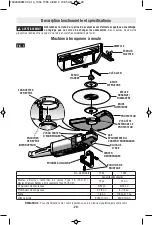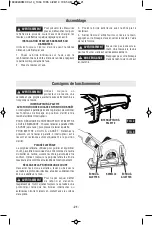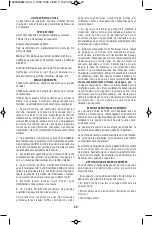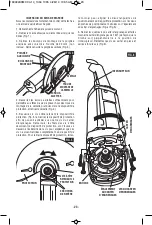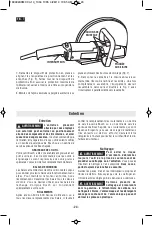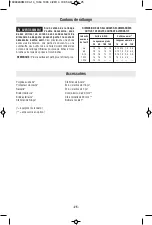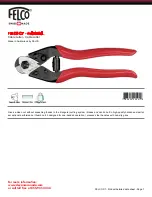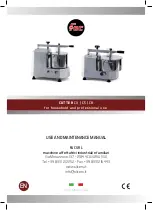
-10-
OPERATING THE TOOL
Following a few simple tips will reduce wear
on the tool and it will reduce the chance of
injury to the operator.
APPLICATIONS
This tool is intended for cutting the following
materials.
1/8˝ maximum thick sheet steel.
Concrete cinder blocks and bricks.
Reinforcing rod-generally under 3/4˝
diameter.
1/8˝ concrete wire mesh.
Corrugated floor and ceiling forms (concrete
forms).
Electrical conduit 1/8˝ wall thickness.
1/8” maximum thick structural forms such as:
channels, angles, plate and etc.
ABRASIVE WHEELS
Use aluminum oxide wheels for cutting metal.
Use silicon carbide wheels for cutting
masonry.
Use dry diamond wheels for cutting concrete.
Dry diamond wheel stay cooler, clogs less
and last longer.
1 Before running a cut-off machine, inspect
the cutting wheel for chips or cracks. Replace
bad wheels immediately. New wheels should
be run in at no load for at least a minute in
direction away from the presence of other
people. Imperfect wheels will normally break
apart during this time.
2. An abrasive cut-off machine must NEVER
be operated without the attached guard
secured in place. The guard should be
rotated into the position where maximum
protection is provided for the operator from
sparks and wheel periphery.
3. Proper apparel for operating the tool
includes eye protection, leather gloves, dust
mask and a shop apron.
4. With the tool in the "OFF" position,
become familiar with handling the tool.
Control the head of the tool with the side
handle. Control the cutting edge of the wheel
with the switch handle. Always use both
hands when operating the tool.
5. Never drop the tool. Set the tool down
gently, but never on the wheel.
6. CUTTING CONCRETE will throw large
amounts of dust into the surrounding
area.
Respiratory protection with minimum N-95
dust masks or respirators are required for the
operator and others in the work area.
7. Due to the size and weight of the cut-off
machine it must not be used be used
overhead or in any position that would not
allow proper control. Ladders or scaffolding
are not considered solid support structures.
8. Avoid overloading tool. Do not allow the
wheel to bind or stall. Many cuts, especially
into solid concrete, require successive
passes. Do not expose any more abrasive
wheel than necessary to cut with normal
amount of pressure applied to tool. Begin
cutting from the edge of the material, starting
with about 1" wheel exposed. Do not force
the tool; load it normally. Depending on
material hardness and density, make
successively deeper passes until cut is
complete.
For dry diamond wheels:
Cutting
masonry / concrete must be done in multiple
passes, scoring the work piece only to the
depth of a segment on each pass. Full depth
of cut in one pass reduces the life of the
body of the blade by thinning it and may
allow the segment to fly away.
FIRE FORWARD/FIRE REVERSE
Models 1364 & 1365 are shipped with
abrasive Cutoff Machine set up in fire forward
position. Both can be easily converted to fire
reverse position without any additional
accessories.
Fire forward position directs sparks, dust and
debris away from the operator.
Fire reverse position changes direction of
rotation so sparks, dust and debris are
thrown toward the operator.
The proper fire position depends on how the
tool is being held, direction of travel, and
personal preference. Always remember the
reason for this feature is to direct sparks,
dust and debris away from the operator.
FIRE REVERSE APPLICATIONS
Below are a few examples of when you may
want to change your tool to the reverse fire
position.
• When cutting in a vertical position to direct
debris toward your feet instead of your face.
• When pulling the tool through the workpiece
instead of pushing the tool.
• When working in confined areas close to a
wall.
• Personal comfort.
160992A0MC 04-14_1364 1365 4/28/14 10:35 AM Page 10




















